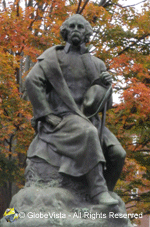Nathaniel Hawthorne statue

Public Art: Nathaniel Hawthorne statue
Sculptor: © Bela Lyon Pratt (December 11, 1867 – May 18, 1917)
Date Unveiled: Unknown
Funded by: It was the Hawthorne Memorial Association who was responsible for raising the funds to buy Bela Pratt’s statue of Nathaniel Hawthorne.
Description: A bronze statue of locally born American novelist and short story writer, Nathaniel Hawthorne (July 4, 1804 – May 19, 1864). The statue depicts a seated Hawthorne with walking stick and hat in hand watching over the neighborhood he grew up in. Yes, Nathaniel was born a block away at a house on 27 Union Street but later, following the death of his father on a voyage to South America, he, his mother and two sisters moved a few doors down to 10 Herbert Street (which he referred to as “Castle Dismal”).
Location: Nathaniel Hawthorne statue can be found on Hawthorne Boulevard next to the Hawthorne Hotel, Salem, Massachusetts.
So who was Nathaniel Hawthorne? : Nathaniel Hawthorne (July 4, 1804 – May 19, 1864) was an American writer best remembered for his novels The House of the Seven Gables and The Scarlet Letter. Hawthorne was born Nathaniel Hathorne in Salem, Massachusetts but later added a “w” in his early 20’s to make it Hawthorne. His uncle Robert Manning, who saw potential in the young Hawthorne, paid for him to attend Bowdoin College. On his way there, during a stagecoach stop in Portland, Hawthorne met future president Franklin Pierce and the two became fast friends.
After graduating from college in 1825 Hawthorne had his first novel Fanshawe published (anonymously). In the following years, he became an editor for the American Magazine of Useful and Entertaining Knowledge and submitted numerous short stories to various magazines and annuals. Hawthorne also worked as a weigher and gauger at the Boston Custom House.
Noted for his extreme shyness, the writer fell in love with and eventually married Sophia Peabody, who was also very much a recluse.
In 1848 Hawthorne lost his job at the Customs House and began writing full time. In 1850 his novel The Scarlet Letter was complete and it was to become one of the first mass-produced books in America. In under two weeks, he had sold 2,500 copies. This novel was followed shortly after by The House of the Seven Gables.
In 1952 Hawthorne wrote the presidential campaign biography for his longtime friend Franklin Pierce titled The Life of Franklin Pierce. Horace Mann scoffed “If he makes out Pierce to be a great man or a brave man, it will be the greatest work of fiction he ever wrote”. Well, he did succeed in cleverly sidestepping the fact that Pierce was an alcoholic and soften the failures of his time as a statesman and soldier, enough for Pierce to find himself the 14th President of the United States. As a reward Hawthorne was given the position of United States consul in Liverpool.
By the time Hawthorne and his family returned to America in 1860, his health had deteriorated. At the outset of the Civil War Hawthorne ventured to Washington D.C. and met with Abraham Lincoln and several other notable figures. This gave him fodder for his essay “Chiefly About War Matters”.
In 1964, despite suffering from stomach pains, Hawthorne took a trip with Franklin Pierce to the White Mountains, but he died in his sleep during the journey.
Trivia:
Hawthorne’s great-great-grandfather was, John Hathorne, was one of the”hanging” judges who oversaw the Salem Witch Trials. It is thought this was the reason he chose to add the “w” to his name to disassociate himself from this.